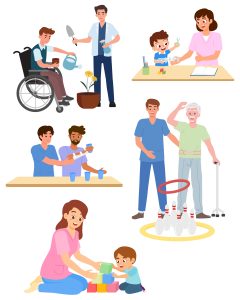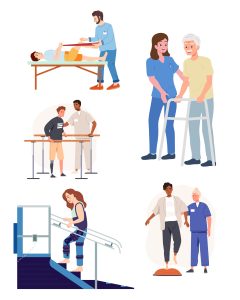3
Occupational Therapy vs Physical Therapy
Occupational therapy aims to assist individuals in rediscovering and engaging in activities that provide joy and meaning to their lives. This therapeutic approach nurtures the individuals’ ability to reconnect with everyday routines, thereby enhancing their participation in meaningful activities. In contrast, physical therapy is an approach aimed at rebuilding strength and restoring mobility. Through exercises and guided techniques, physical therapy empowers individuals to reclaim their physical capabilities and achieve newfound freedom of movement. Together, these therapeutic disciplines form a powerful alliance, substantially enriching overall well-being and elevating the quality of life.
Occupational Therapy Practitioner role:
Occupational therapists care for patients with injuries, illnesses, and disabilities to help them achieve independence in their daily activities.
What does an Occupational Therapist do?
- Observe a patient’s medical condition and intake form
- Ask questions on how they perform tasks at home, work, outside, etc.
- Create a treatment plan to help the patient achieve independence and reach their goals
Depending on the patient’s condition, occupational therapists can:
- Help patients with feeding and eating, dressing, brushing teeth, washing their face, etc.
- Educate patients on functional exercises to stretch their body to decrease pain and soreness
- Evaluate their home to assess for safety and offer modifications based on problem areas
- Educate family and friends on how they can support their loved one
- Offer suggestions on equipment and tools to make tasks easier such as dressing and eating
Physical Therapy Practitioner role:

Physical therapists assist patients that are sick or injured to regain movement and promote pain management
What does an Physical Therapist do?
- Observe a patient’s medical condition and intake form
- Observe a patient’s functional movements by watching how they stand, walk, etc.
Depending on the patient’s condition, physical therapists can:
- Create a treatment plan to help the patient reduce pain, improve mobility, and increase ROM through use of stretching, exercises, equipment, and hands-on techniques
- Implement canes, crutches, wheelchairs, and walkers depending on patient’s state of mobility
- Identify techniques to improve
OT and PT in women’s healthcare
Let’s dive into the ways occupational therapy and physical therapy play unique roles in women’s healthcare!
Occupational therapy focuses on empowering women to engage in everyday activities and routines, helping them overcome challenges posed by physical, emotional, or social barriers. Whether it’s aiding recovery after childbirth, managing chronic conditions, or adjusting to life changes, occupational therapists provide personalized strategies and tools to enhance daily life and promote well-being.
On the other hand, physical therapy zeroes in on improving physical function and mobility. For women dealing with issues such as pelvic pain, postpartum recovery, or sports-related injuries, physical therapists offer specialized interventions designed to restore strength, flexibility, and overall physical health.
Both occupational therapy and physical therapy play essential roles in enhancing women’s health, but they do so through different methods and focus areas. Each discipline contributes unique approaches that are vital for addressing the diverse healthcare needs of women. Practitioners in both fields utilize exercises, manual therapy techniques, and educational resources to empower women in reclaiming their physical abilities and improving their quality of life.
Key Takeaways
- Occupational therapy and physical therapy are essential aspects of healthcare that assist patients in returning to the activities they enjoy in their lives.
Exercises
- Compare and contrast how occupational therapy and physical therapy contribute to women’s healthcare in distinct ways
Explore
References:
Bureau of Labor Statistics, U.S. Department of Labor, Occupational Outlook Handbook, Occupational Therapists,
at https://www.bls.gov/ooh/healthcare/occupational-therapists.htm
Bureau of Labor Statistics, U.S. Department of Labor, Occupational Outlook Handbook, Physical Therapists,
at https://www.bls.gov/ooh/healthcare/physical-therapists.htm
Media Attributions
- ot
- pt
